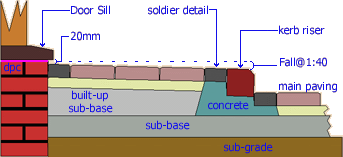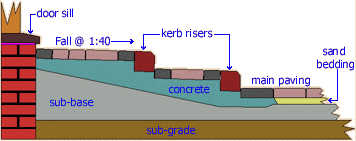Page 1 of 1
Posted: Mon Aug 13, 2018 3:55 pm
by adrianH
I have an area of block paving 6m*3m which (thanks to Tony and his site) I put in last year - it bridges the gap between the pavement and garage and serves as my drive.
I will shortly be adding to this with another flat square area 1.05m*8m that runs the length of the house.
There will be additional block paving steps and arcs to connect these two areas together and provide access to the house, and whilst a sand laying course plate-whacked down is how I'll tackle the big areas, and a lean mix infill with 6:1 laying course is how I'll tackle the steps too small to accommodate the whacker, I wonder where is the line where it becomes practical to get the whacker out again?
I am thinking specifically of the path connecting these two areas, which is going to be about 3m long and 1m wide, with a *fairly* (for me) tricky arc and gradient.
Would you have a sand laying course for that or do it with concrete?
Bonus round: when using a 6:1 grit sand:cement laying course for block paving, how deep would you make it?
Thank you all!
Posted: Mon Aug 13, 2018 11:29 pm
by lutonlagerlout
depends on the area Adrian
if you go the rigid route I would aim for 40-50 mm of laying course
cheers LLL 
Posted: Tue Aug 14, 2018 5:21 pm
by adrianH
Thanks mate - I think I am going to go with the rigid base for these bits, it will save me the headache of the whacking going wrong in tight small spaces.
Posted: Sun Sep 16, 2018 3:46 pm
by adrianH
Follow up question then, I’ve got four areas to fill of approx 750*750, ie too small to whack so I’m doing sand and cement laying course.
I can’t actually find anything on the main site relating to how to use a sand and cement laying course with block paving, ie in the context like mine of steps. Shall I manually compact then screed it to the full depth of the block?
Posted: Mon Sep 17, 2018 8:28 am
by seanandruby
Would normally put in a concrete/tarmac base layer, lay edgings to stop sand migration and lay on 40/50 ml sharp sand. Solid bedding layer on flexible base will fail. For steps you need to put in a concrete base and then lay your blocks as you would lay bricks with mortar.
Posted: Tue Sep 18, 2018 12:53 pm
by adrianH
Right ho mate thank you.
Would you mind casting an eye over the below to make sure I've got the right end of the stick?
So I've got to make four steps of approx 1m*1m at steadily increasing levels from the existing flexible paving up to the pavement.
So far all I have done is the clearing & excavation. It sounds like you're saying I'm best off doing this rigid rather than flexible so can you put me right on any of the following:
No sub base (or type 1 sub base?)
Concrete base
Concrete haunched edge courses
Concrete infill
Sand laying course (40-50mm)
Blocks & Jointing sand
Thank you!
Posted: Tue Sep 18, 2018 6:15 pm
by seanandruby
Concrete base,
Brickwork,
Infill with concrete,
Paving,
Brickwork,
Infill,
Paving layer... and on and on.look here
Posted: Tue Sep 18, 2018 10:20 pm
by adrianH
Thank you Sean that’s great. So you’ve brung me full circle back to the original question of how to work that laying course when not using a whacker (area too small)
Using sand, am I to manually compact individual blocks to final level with a rubber mallet?
If I have a bound base wouldn’t a sand and cement laying course be a better bet (less scope for compaction)?
Sorry if it seems a dumb question. I’ve read the page you linked many times and It doesn’t cover how to work that laying course.
This diagram indicates laying course but doesn’t say what it is or how to work it, only that a whacker might not be used.

Conversely this diagram has no laying course and again doesn’t tell me how to work it:

You said before solid laying course on a flexible base will fail - is that not what’s pictured here because the laying course and the base are effectively one?
Posted: Wed Sep 19, 2018 12:34 pm
by seanandruby
Yes you can tap them down using a mallet where you can't access with a wacker. Those steps are laid on cbm in one, that is the laying course of course. You can do it that way if you so wish but why i advised a base first then mortar is because being a diyer you might not keep up with it. Steps can be a challenge even for the expert when up against it i e concrete going off. Hope this helps.

